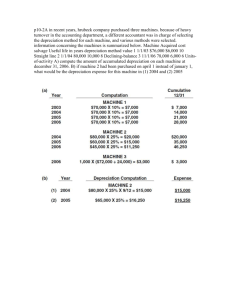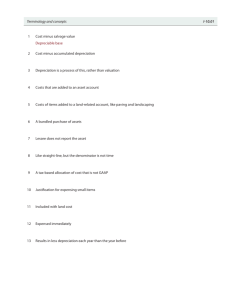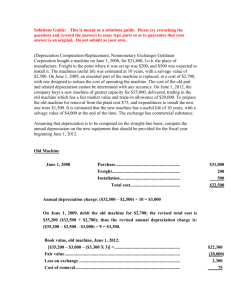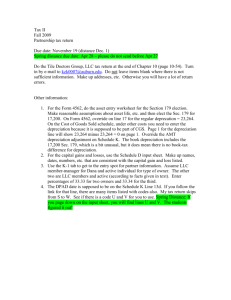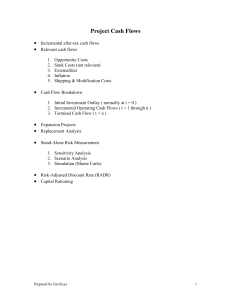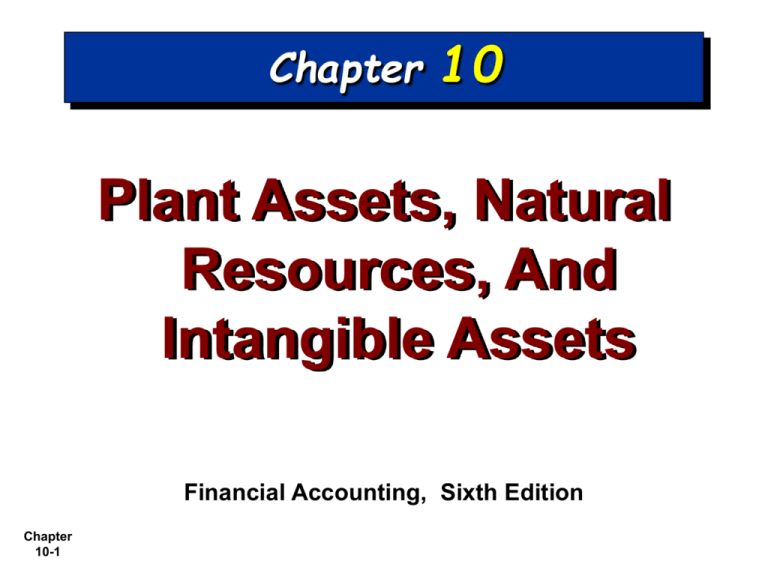
Chapter
10
Plant Assets, Natural
Resources, And
Intangible Assets
Financial Accounting, Sixth Edition
Chapter
10-1
Study Objectives
1.
Describe how the cost principle applies to plant assets.
2.
Explain the concept of depreciation.
3.
Compute periodic depreciation using different methods.
4.
Describe the procedure for revising periodic depreciation.
5.
Distinguish between revenue and capital expenditures, and
explain the entries for each.
6.
Explain how to account for the disposal of a plant asset.
7.
Compute periodic depletion of natural resources.
8.
Explain the basic issues related to accounting for intangible
assets.
9.
Indicate how plant assets, natural resources, and intangible
assets are reported.
Chapter
10-2
Plant Assets, Natural Resources,
and Intangible Assets
Plant Assets
Determining
the cost of
plant assets
Depreciation
Expenditures
during useful
life
Plant asset
disposals
Chapter
10-3
Natural
Resources
Depletion
Intangible
Assets
Accounting for
intangibles
Research and
development
costs
Statement
Presentation
and Analysis
Presentation
Analysis
Section 1 – Plant Assets
Plant assets include land, land improvements,
buildings, and equipment (machinery, furniture, tools).
Major characteristics include:
“Used in operations” and not for resale.
Long-term in nature and usually depreciated.
Possess physical substance.
Referred to as property, plant, and equipment; plant and
equipment; and fixed assets.
Chapter
10-4
Determining the Cost of Plant Assets
Land
Includes all costs to acquire land and ready it for use.
Costs typically include:
(1) the purchase price;
(2) closing costs, such as title and attorney’s fees;
(3) real estate brokers’ commissions;
(4) costs of grading, filling, draining, and clearing;
(5) assumption of any liens, mortgages, or
encumbrances on the property.
Chapter
10-5
SO 1 Describe how the cost principle applies to plant assets.
Determining the Cost of Plant Assets
Land Improvements
Includes all expenditures necessary to make the
improvements ready for their intended use.
Examples are driveways, parking lots, fences,
landscaping, and underground sprinklers.
Limited useful lives.
Expense (depreciate) the cost of land
improvements over their useful lives.
Chapter
10-6
SO 1 Describe how the cost principle applies to plant assets.
Determining the Cost of Plant Assets
Buildings
Includes all costs related directly to purchase or
construction.
Purchase costs:
Purchase price, closing costs (attorney’s fees, title
insurance, etc.) and real estate broker’s commission.
Remodeling and replacing or repairing the roof, floors,
electrical wiring, and plumbing.
Construction costs:
Contract price plus payments for architects’ fees,
building permits, and excavation costs.
Chapter
10-7
SO 1 Describe how the cost principle applies to plant assets.
Determining the Cost of Plant Assets
E10-3 On March 1, 2008, Penner Company acquired real
estate on which it planned to construct a small office
building. The company paid $80,000 in cash. An old
warehouse on the property was razed at a cost of $8,600;
the salvaged materials were sold for $1,700. Additional
expenditures before construction began included $1,100
attorney’s fee for work concerning the land purchase, $5,000
real estate broker’s fee, $7,800 architect’s fee, and $14,000
to put in driveways and a parking lot.
Instructions
Determine amount to be reported as the cost of the land.
For each cost not used, indicate the account debited.
Chapter
10-8
SO 1 Describe how the cost principle applies to plant assets.
Determining the Cost of Plant Assets
E10-3 Determine amount to be reported as the cost of the
land.
Land
Company paid $80,000 in cash.
$80,000
Old warehouse razed at a cost of $8,600
Salvaged materials were sold for $1,700.
8,600
- 1,700
Expenditures before construction began:
$1,100 attorney’s fee for work on land purchase.
$5,000 real estate broker’s fee.
$7,800 architect’s fee.
5,000
Building
Chapter
10-9
0
0
$14,000 for driveways and parking lot.
Land Improvements
1,100
Total
$93,000
SO 1 Describe how the cost principle applies to plant assets.
Determining the Cost of Plant Assets
Equipment
Include all costs incurred in acquiring the equipment
and preparing it for use.
Costs typically include:
purchase price,
sales taxes,
freight and handling charges,
insurance on the equipment while in transit,
assembling and installation costs, and
costs of conducting trial runs.
Chapter
10-10
SO 1 Describe how the cost principle applies to plant assets.
Depreciation
Depreciation is the process of allocating the cost of
tangible assets to expense in a systematic and rational
manner to those periods expected to benefit from the
use of the asset.
Process of cost allocation, not asset valuation.
Applies to land improvements, buildings, and
equipment, not land.
Depreciable, because the revenue-producing
ability of asset will decline over the asset’s
useful life.
Chapter
10-11
SO 2 Explain the concept of depreciation.
Depreciation
Factors in Computing Depreciation
Cost
Chapter
10-12
Useful Life
Illustration 10-6
Salvage Value
SO 2 Explain the concept of depreciation.
Depreciation
Depreciation Methods
Objective is to select the method that best measures
an asset’s contribution to revenue over its useful life.
Examples include:
(1) Straight-line method.
(2) Units-of-Activity method.
(3) Declining-balance method.
Illustration 10-8
Use of depreciation
methods in 600 large
U.S. companies
Chapter
10-13
SO 3 Compute periodic depreciation using different methods.
Depreciation
Exercise (Depreciation Computations—Three Methods)
Parish Corporation purchased a new machine for its assembly
process on January 2, 2007. The cost of this machine was
$117,900. The company estimated that the machine would
have a salvage value of $12,900 at the end of its service life.
Its life is estimated at 5 years and its working hours are
estimated at 1,000 hours. Year-end is December 31.
Instructions: Compute the depreciation expense under the
following methods.
(a) Straight-Line.
(b) Units-of-Activity.
(c) Double-Declining Balance.
Chapter
10-14
SO 3 Compute periodic depreciation using different methods.
Depreciation
Straight-Line
Expense is same amount for each year.
Depreciable cost is
cost of the asset less
its salvage value.
Illustration 10-10
Straight-line method
predominates in
practice.
Chapter
10-15
SO 3 Compute periodic depreciation using different methods.
Depreciation
Exercise (Straight-Line Method)
Year
Depreciable
Base
2007
$ 105,000
/
5
=
$ 21,000
$ 21,000
2008
105,000
/
5
=
21,000
42,000
2009
105,000
/
5
=
21,000
63,000
2010
105,000
/
5
=
21,000
84,000
2011
105,000
/
5
=
21,000
105,000
Years
Annual
Expense
Accum.
Deprec.
$ 105,000
Journal entry 2007
Depreciation expense
Accumulated depreciation
Chapter
10-16
21,000
21,000
SO 3 Compute periodic depreciation using different methods.
Depreciation – Partial Year
Exercise (Straight-line Method)
Year
Depreciable
Base
Annual
Expense
2007
$ 105,000
/
5
=
$ 21,000
2008
105,000
/
5
=
2009
105,000
/
5
2010
105,000
/
2011
105,000
2012
105,000
Years
Current
Year
Expense
Partial
Year
x
5,250
$ 5,250
21,000
21,000
26,250
=
21,000
21,000
47,250
5
=
21,000
21,000
68,250
/
5
=
21,000
21,000
89,250
/
5
=
21,000
15,750
105,000
x
3/12
9/12
=
=
$
Accum.
Deprec.
$ 105,000
Journal entry:
2007
Depreciation expense
Accumultated depreciation
Chapter
10-17
5,250
5,250
SO 3 Compute periodic depreciation using different methods.
Depreciation
Units-of-Activity
Expense varies based on units of activity.
Depreciable cost is cost
less salvage value.
Illustration 10-12
Companies estimate
total units of activity to
calculate depreciation
cost per unit.
Chapter
10-18
SO 3 Compute periodic depreciation using different methods.
Depreciation
Exercise (Units-of-Activity Method)
($105,000 / 1,000 hours = $105 per hour)
Year
Hours
Used
2007
200
x
$105
=
$ 21,000
$ 21,000
2008
150
x
105
=
15,750
36,750
2009
250
x
105
=
26,250
63,000
2010
300
x
105
=
31,500
94,500
2011
100
x
105
=
10,500
105,000
1,000
Chapter
10-19
Rate per
Hour
Annual
Expense
Accum.
Deprec.
$ 105,000
SO 3 Compute periodic depreciation using different methods.
Depreciation – Partial Year
Exercise (Units-of-Activity Method)
($105,000 / 1,000 hours = $105 per hour)
Year
(Given)
Hours
Used
Rate per
Hours
Annual
Expense
Partial
Year
Current
Year
Expense
Accum.
Deprec.
2007
160
x
$105
=
$ 16,800
$ 16,800
$ 16,800
2008
150
x
105
=
15,750
15,750
32,550
2009
250
x
105
=
26,250
26,250
58,800
2010
300
x
105
=
31,500
31,500
90,300
2011
100
x
105
=
10,500
10,500
100,800
2012
40
x
105
=
4,200
4,200
105,000
1,000
$ 105,000
Journal entry:
2007
Depreciation expense
Accumultated depreciation
Chapter
10-20
16,800
16,800
SO 3 Compute periodic depreciation using different methods.
Depreciation
Double-Declining-Balance
Decreasing annual depreciation expense over the
asset’s useful life.
Illustration 10-14
Declining-balance rate
is double the straightline rate.
Rate applied to book
value (cost less
accumulated
depreciation).
Chapter
10-21
SO 3 Compute periodic depreciation using different methods.
Depreciation
Exercise (Double-Declining Balance Method)
Year
Net
Bookvalue
Rate per
Year
Annual
Expense
Accum.
Deprec.
2007
$ 117,900
x
40%
=
$ 47,160
$ 47,160
2008
70,740
x
40%
=
28,296
75,456
2009
42,444
x
40%
=
16,978
92,434
2010
25,466
x
40%
=
10,186
102,620
2011
15,280
x
40%
=
2,380
105,000
$105,000
Chapter
10-22
Plug
SO 3 Compute periodic depreciation using different methods.
Depreciation – Partial Year
Exercise (Double-Declining Balance Method)
Year
Depreciable
Base
Rate
per Year
Annual
Expense
2007
$ 117,900 x
40%
=
2008
106,110 x
40%
=
2009
72,509 x
40%
2010
54,381 x
2011
2012
$ 47,160 x
Partial
Year
3/12
Current
Year
Expense
Accum.
Deprec.
= $ 11,790
$ 11,790
33,602
33,602
45,392
=
18,127
18,127
63,519
40%
=
9,970
9,970
73,489
44,411 x
40%
=
5,181
5,181
78,670
39,230 x
40%
=
1,962
26,330
105,000
Plug
$ 105,000
Journal entry:
2007
Depreciation expense
Accumultated depreciation
Chapter
10-23
11,790
11,790
SO 3 Compute periodic depreciation using different methods.
Illustration 10-16
Depreciation
Comparison of
Depreciation Methods
Annual Expense
Year
Chapter
10-24
SL
DDB
Activity
2007
21,000
47,160
21,000
2008
21,000
28,296
15,750
2009
21,000
16,978
26,250
2010
21,000
10,186
31,500
2011
21,000
2,380
10,500
105,000
105,000
105,000
SO 3 Compute periodic depreciation using different methods.
Depreciation
Depreciation and Income Taxes
IRS does not require taxpayer to use the same
depreciation method on the tax return that is used in
preparing financial statements.
IRS requires the Modified Accelerated Cost
Recovery System, which is NOT acceptable under
GAAP.
Chapter
10-25
SO 3 Compute periodic depreciation using different methods.
Depreciation
Revising Periodic Depreciation
Accounted for in the period of change and
future periods (Change in Estimate).
Not handled retrospectively.
Not considered error.
Chapter
10-26
SO 4 Describe the procedure for revising periodic depreciation.
Depreciation
Arcadia HS purchased equipment for $510,000 which
was estimated to have a useful life of 10 years with a
salvage value of $10,000 at the end of that time.
Depreciation has been recorded for 7 years on a
straight-line basis. In 2008 (year 8), it is determined
that the total estimated life should be 15 years with a
salvage value of $5,000 at the end of that time.
Questions:
What is the journal entry to correct
the prior years’ depreciation?
Calculate the depreciation expense
for 2008.
Chapter
10-27
No Entry
Required
SO 4 Describe the procedure for revising periodic depreciation.
Depreciation
Equipment cost
Salvage value
Depreciable base
Useful life (original)
Annual depreciation
After 7 years
$510,000
First, establish
- 10,000
NBV at date of
change in estimate.
500,000
10 years
$ 50,000 x 7 years = $350,000
Balance Sheet (Dec. 31, 2007)
Fixed Assets:
Chapter
10-28
Equipment
Accumulated depreciation
$510,000
350,000
Net book value (NBV)
$160,000
SO 4 Describe the procedure for revising periodic depreciation.
Depreciation
Net book value
Salvage value (new)
Depreciable base
Useful life remaining
Annual depreciation
After 7 years
$160,000
5,000
155,000
8 years
$ 19,375
Depreciation
Expense calculation
for 2008.
Journal entry for 2008
Depreciation expense
Accumulated depreciation
Chapter
10-29
19,375
19,375
SO 4 Describe the procedure for revising periodic depreciation.
Expenditures During Useful Life
Ordinary Repairs - expenditures to maintain the
operating efficiency and productive life of the unit.
Debit - Repair (or Maintenance) Expense.
Referred to as revenue expenditures.
Additions and Improvements - costs incurred to
increase the operating efficiency, productive capacity, or
useful life of a plant asset.
Debit - the plant asset affected.
Referred to as capital expenditures.
Chapter
10-30
SO 5 Distinguish between revenue and capital expenditures,
and explain the entries for each.
Plant Asset Disposals
Companies dispose of plant assets in three ways —
Retirement, Sale, or Exchange (appendix).
Illustration 10-18
Record depreciation up to the date of disposal.
Eliminate asset by (1) debiting Accumulated Depreciation, and
(2) crediting the asset account.
Chapter
10-31
SO 6 Explain how to account for the disposal of a plant asset.
Plant Asset Disposals - Retirement
BE10-9 Prepare journal entries to record the following.
(a) Gomez Company retires its delivery equipment, which cost
$41,000. Accumulated depreciation is also $41,000 on this
delivery equipment. No salvage value is received.
(b) Assume the same information as (a), except that
accumulated depreciation for Gomez Company is $39,000,
instead of $41,000.
(a)
Chapter
10-32
Accumulated depreciation
Equipment
41,000
41,000
SO 6 Explain how to account for the disposal of a plant asset.
Plant Asset Disposals - Retirement
BE10-9 Prepare journal entries to record the following.
(a) Gomez Company retires its delivery equipment, which cost
$41,000. Accumulated depreciation is also $41,000 on this
delivery equipment. No salvage value is received.
(b) Assume the same information as (a), except that
accumulated depreciation for Gomez Company is $39,000,
instead of $41,000.
(b)
Accumulated depreciation
Equipment
Loss on disposal
Chapter
10-33
39,000
41,000
2,000
SO 6 Explain how to account for the disposal of a plant asset.
Plant Asset Disposals
Sale of Plant Assets
Compare the book value of the asset with the
proceeds received from the sale.
If proceeds exceed the book value, a gain on
disposal occurs.
If proceeds are less than the book value, a loss
on disposal occurs.
Chapter
10-34
SO 6 Explain how to account for the disposal of a plant asset.
Plant Asset Disposals - Sale
BE10-10 Chan Company sells office equipment on
September 30, 2008, for $20,000 cash. The office
equipment originally cost $72,000 and as of January 1,
2008, had accumulated depreciation of $42,000.
Depreciation for the first 9 months of 2008 is $5,250.
Prepare the journal entries to (a) update depreciation to
September 30, 2008, and (b) record the sale of the
equipment.
Chapter
10-35
SO 6 Explain how to account for the disposal of a plant asset.
Plant Asset Disposals - Sale
BE10-10 Prepare the journal entries to (a) update
depreciation to September 30, 2008, and (b) record the
sale of the equipment.
(a)
(b)
Depreciation expense
Accumulated depreciation
Cash
Accumulated depreciation
Office equipment
Loss on disposal
Chapter
10-36
5,250
5,250
20,000
47,250
72,000
4,750
SO 6 Explain how to account for the disposal of a plant asset.
Section 2 – Natural Resources
Natural resources consist of standing timber and
underground deposits of oil, gas, and minerals.
Distinguishing characteristics:
Physically extracted in operations.
Replaceable only by an act of nature.
Chapter
10-37
Section 2 – Natural Resources
Cost - price needed to acquire the resource and
prepare it for its intended use.
Depletion - allocation of the cost to expense in a rational
and systematic manner over the resource’s useful life.
Depletion is to natural resources as depreciation
is to plant assets.
Companies generally use units-of-activity method.
Depletion generally is a function of the units
extracted.
Chapter
10-38
SO 7 Compute periodic depletion of natural resources.
Section 2 – Natural Resources
BE10-11 Olpe Mining Co. purchased for $7 million a
mine that is estimated to have 35 million tons of ore and
no salvage value. In the first year, 6 million tons of ore
are extracted and sold. (a) Prepare the journal entry
to record depletion expense for the first year. (b)
Show how this mine is reported on the balance sheet at
the end of the first year.
Depletion cost per unit = $7,000,000 ÷ 35,000,000 =
$.20 depletion cost per ton
$.20 X 6,000,000 = $1,200,000
Chapter
10-39
SO 7 Compute periodic depletion of natural resources.
Section 2 – Natural Resources
BE10-11 (a) Prepare the journal entry to record
depletion expense for the first year. (b) Show how this
mine is reported on the balance sheet at the end of the
first year.
(a)
(b)
Chapter
10-40
Depletion expense
Accumulated depletion
1,200,000
1,200,000
Ore mine
7,000,000
Less: Accumulated depletion
1,200,000
Net book value
5,800,000
SO 7 Compute periodic depletion of natural resources.
Section 3 – Intangible Assets
Intangible assets are rights, privileges, and
competitive advantages that do not possess physical
substance.
Normally classified as long-term asset.
Common types of intangibles:
Patents
Trademarks or trade names
Copyrights
Goodwill
Franchises or licenses
Chapter
10-41
Accounting for Intangible Assets
Valuation
Purchased Intangibles:
Recorded at cost.
Includes all costs necessary to make the intangible
asset ready for its intended use.
Internally Created Intangibles:
Generally expensed.
Only capitalize direct costs incurred in perfecting title
to the intangible, such as legal costs.
Chapter
10-42
SO 8 Explain the basic issues related to accounting for intangible assets.
Accounting for Intangible Assets
Amortization of Intangibles
Limited-Life Intangibles:
Amortize to expense.
Credit asset account or accumulated amortization.
Indefinite-Life Intangibles:
No foreseeable limit on time the asset is expected to
provide cash flows.
No amortization.
Chapter
10-43
SO 8 Explain the basic issues related to accounting for intangible assets.
Accounting for Intangible Assets
Patents
Exclusive right to manufacture, sell, or otherwise
control an invention for a period of 20 years from the
date of the grant.
Capitalize costs of purchasing a patent and amortize
over its 20-year life or its useful life, whichever is
shorter.
Expense any R&D costs in developing a patent.
Legal fees incurred successfully defending a patent
are capitalized to Patent account.
Chapter
10-44
SO 8 Explain the basic issues related to accounting for intangible assets.
Accounting for Intangible Assets
BE10-12 Galena Company purchases a patent for
$120,000 on January 2, 2008. Its estimated useful life is
10 years. (a) Prepare the journal entry to record patent
expense for the first year. (b) Show how this patent is
reported on the balance sheet at the end of the first
year.
(a)
Amortization expense
Patent
(b)
12,000
Intangibles:
Patent
Chapter
10-45
12,000
108,000
SO 8 Explain the basic issues related to accounting for intangible assets.
Accounting for Intangible Assets
Copyrights
Give the owner the exclusive right to reproduce and
sell an artistic or published work.
plays, literary works, musical works, pictures,
photographs, and video and audiovisual material.
Copyright is granted for the life of the creator plus
70 years.
Capitalize acquisition costs.
Amortized to expense over useful life.
Chapter
10-46
SO 8 Explain the basic issues related to accounting for intangible assets.
Accounting for Intangible Assets
Trademarks and Trade Names
Word, phrase, jingle, or symbol that identifies a
particular enterprise or product.
Wheaties, Game Boy, Frappuccino, Kleenex,
Windows, Coca-Cola, and Jeep.
Trademark or trade name has legal protection for
indefinite number of 10 year renewal periods.
Capitalize acquisition costs.
No amortization.
Chapter
10-47
SO 8 Explain the basic issues related to accounting for intangible assets.
Accounting for Intangible Assets
Franchises and Licenses
Contractual arrangement between a franchisor and a
franchisee.
Shell, Taco Bell, or Rent-A-Wreck are franchises.
Franchise (or license) with a limited life should be
amortized to expense over the life of the franchise.
Franchise with an indefinite life should be carried at
cost and not amortized.
Chapter
10-48
SO 8 Explain the basic issues related to accounting for intangible assets.
Accounting for Intangible Assets
Goodwill
Includes exceptional management, desirable location,
good customer relations, skilled employees, high-quality
products, etc.
Only recorded when an entire business is purchased.
Goodwill is recorded as the excess of ...
purchase price over the FMV of the identifiable net
assets acquired.
Internally created goodwill should not be capitalized.
Chapter
10-49
SO 8 Explain the basic issues related to accounting for intangible assets.
Research and Development Costs
Frequently results in something that a company
patents or copyrights such as:
new product,
process,
idea,
formula,
composition, or
literary work.
All R & D costs are expensed when incurred.
Chapter
10-50
SO 8 Explain the basic issues related to accounting for intangible assets.
Statement Presentation and Analysis
Presentation
Illustration 10-24
Companies usually include natural resources under “Property, plant,
and equipment” and show intangibles separately.
Chapter
10-51
SO 9 Indicate how plant assets, natural resources,
and intangible assets are reported.
Statement Presentation and Analysis
Analysis
Illustration 10-25
Each dollar invested in assets produced $0.96 in sales.
If a company is using its assets efficiently, each dollar
of assets will create a high amount of sales.
Chapter
10-52
SO 9 Indicate how plant assets, natural resources,
and intangible assets are reported.
All About You
Buying a Wreck of Your Own
Could you maximize your economic well being by
buying a used car rather than a new one?
Some Facts:
In a recent year, nearly 17 million new cars were sold in
the U.S., compared to sales of 44 million used cars.
The cost of an average new car has risen in recent years,
to about $22,000. The price of the average used car has
actually been falling, and is now about $8,100.
Financial institutions typically require a down payment of
at least 10% of the value of a vehicle on a vehicle loan.
Chapter
10-53
All About You
Buying a Wreck of Your Own
Some Facts:
Interest rates on used-car loans are higher than on newcar loans.
A new car typically loses at least 30% of its value during
the first two years, and 40 to 50% after three years.
The price of new cars has increased faster than average
annual incomes in recent years.
To keep monthly car payments down, car companies will
now provide financing for up to six years. With such a
long loan, you might end up “upside down on the loan.”
Chapter
10-54
All About You
Comparison of total
costs over five years
for the typical new
versus used car.
Source: Phillip Reed, “Compare the
Costs: Buying vs. Leasing vs. Buying a
Used Car,”
www.edmunds.com/advice/buying/art
icles/47079/article.html (accessed
May 2006).
Chapter
10-55
All About You
What Do You Think?
Should you buy a new car?
YES: I don’t want to worry about my car breaking
down—and if it does break down, I want it to be
covered by a warranty. Besides, I have an image to
maintain—I don’t want to be seen in anything less than
the latest styling and the latest technology.
NO: I’m a college student, and I need to keep my costs
down. Cars are a lot more dependable than they used to
be. In addition, my self-image is strong enough that I
don’t need a fancy new car to feel good about myself.
Chapter
10-56
Copyright
“Copyright © 2008 John Wiley & Sons, Inc. All rights reserved.
Reproduction or translation of this work beyond that permitted
in Section 117 of the 1976 United States Copyright Act without
the express written permission of the copyright owner is
unlawful. Request for further information should be addressed
to the Permissions Department, John Wiley & Sons, Inc. The
purchaser may make back-up copies for his/her own use only
and not for distribution or resale. The Publisher assumes no
responsibility for errors, omissions, or damages, caused by the
use of these programs or from the use of the information
contained herein.”
Chapter
10-57

